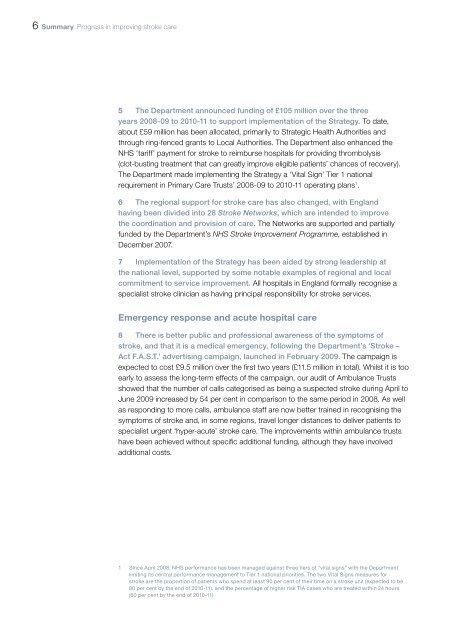Progress in improving stroke care - National Audit Office
Progress in improving stroke care - National Audit Office
Progress in improving stroke care - National Audit Office
You also want an ePaper? Increase the reach of your titles
YUMPU automatically turns print PDFs into web optimized ePapers that Google loves.
6 Summary <strong>Progress</strong> <strong>in</strong> improv<strong>in</strong>g <strong>stroke</strong> <strong>care</strong>5 The Department announced fund<strong>in</strong>g of £105 million over the threeyears 2008-09 to 2010-11 to support implementation of the Strategy. To date,about £59 million has been allocated, primarily to Strategic Health Authorities andthrough r<strong>in</strong>g-fenced grants to Local Authorities. The Department also enhanced theNHS ‘tariff’ payment for <strong>stroke</strong> to reimburse hospitals for provid<strong>in</strong>g thrombolysis(clot‐bust<strong>in</strong>g treatment that can greatly improve eligible patients’ chances of recovery).The Department made implement<strong>in</strong>g the Strategy a ‘Vital Sign’ Tier 1 nationalrequirement <strong>in</strong> Primary Care Trusts’ 2008-09 to 2010-11 operat<strong>in</strong>g plans 1 .6 The regional support for <strong>stroke</strong> <strong>care</strong> has also changed, with Englandhav<strong>in</strong>g been divided <strong>in</strong>to 28 Stroke Networks, which are <strong>in</strong>tended to improvethe coord<strong>in</strong>ation and provision of <strong>care</strong>. The Networks are supported and partiallyfunded by the Department’s NHS Stroke Improvement Programme, established <strong>in</strong>December 2007.7 Implementation of the Strategy has been aided by strong leadership atthe national level, supported by some notable examples of regional and localcommitment to service improvement. All hospitals <strong>in</strong> England formally recognise aspecialist <strong>stroke</strong> cl<strong>in</strong>ician as hav<strong>in</strong>g pr<strong>in</strong>cipal responsibility for <strong>stroke</strong> services.Emergency response and acute hospital <strong>care</strong>8 There is better public and professional awareness of the symptoms of<strong>stroke</strong>, and that it is a medical emergency, follow<strong>in</strong>g the Department’s ‘Stroke –Act F.A.S.T.’ advertis<strong>in</strong>g campaign, launched <strong>in</strong> February 2009. The campaign isexpected to cost £9.5 million over the first two years (£11.5 million <strong>in</strong> total). Whilst it is tooearly to assess the long-term effects of the campaign, our audit of Ambulance Trustsshowed that the number of calls categorised as be<strong>in</strong>g a suspected <strong>stroke</strong> dur<strong>in</strong>g April toJune 2009 <strong>in</strong>creased by 54 per cent <strong>in</strong> comparison to the same period <strong>in</strong> 2008. As wellas respond<strong>in</strong>g to more calls, ambulance staff are now better tra<strong>in</strong>ed <strong>in</strong> recognis<strong>in</strong>g thesymptoms of <strong>stroke</strong> and, <strong>in</strong> some regions, travel longer distances to deliver patients tospecialist urgent ‘hyper-acute’ <strong>stroke</strong> <strong>care</strong>. The improvements with<strong>in</strong> ambulance trustshave been achieved without specific additional fund<strong>in</strong>g, although they have <strong>in</strong>volvedadditional costs.1 S<strong>in</strong>ce April 2008, NHS performance has been managed aga<strong>in</strong>st three tiers of “vital signs” with the Departmentlimit<strong>in</strong>g its central performance management to Tier 1 national priorities. The two Vital Signs measures for<strong>stroke</strong> are the proportion of patients who spend at least 90 per cent of their time on a <strong>stroke</strong> unit (expected to be80 per cent by the end of 2010-11), and the percentage of higher risk TIA cases who are treated with<strong>in</strong> 24 hours(60 per cent by the end of 2010-11)

















